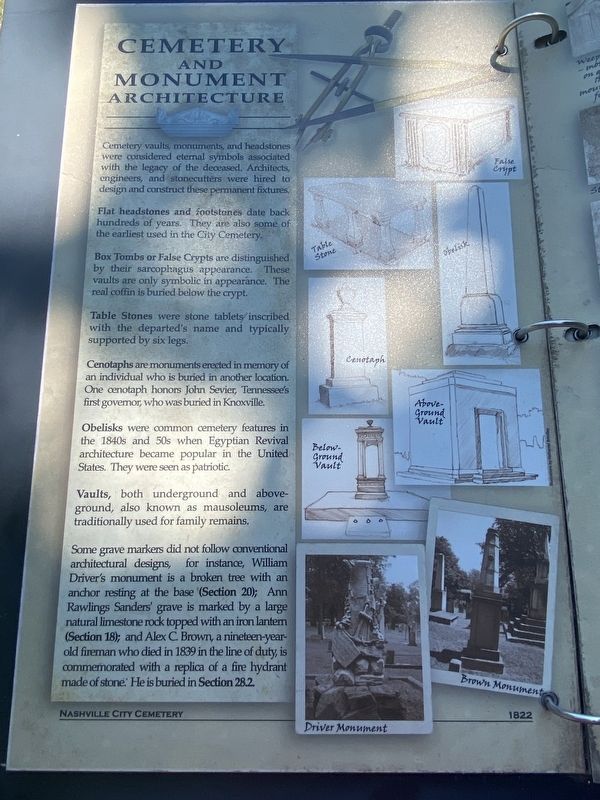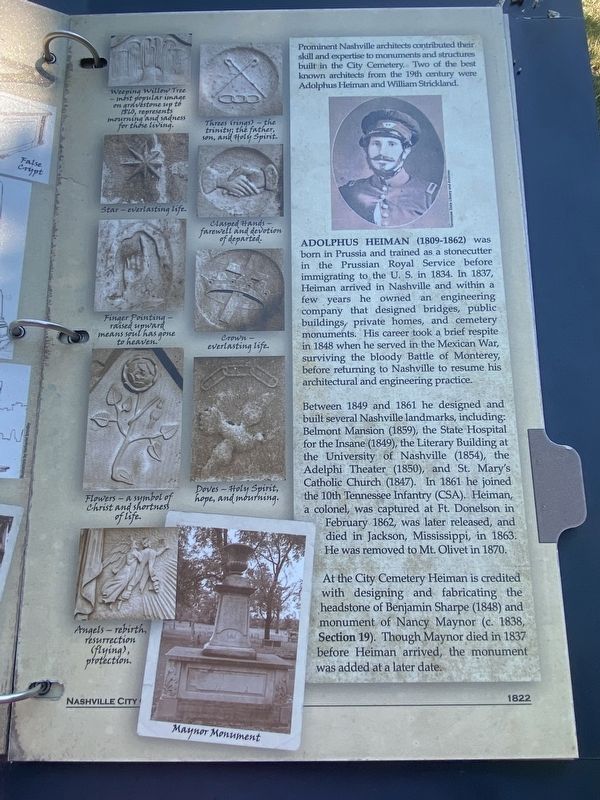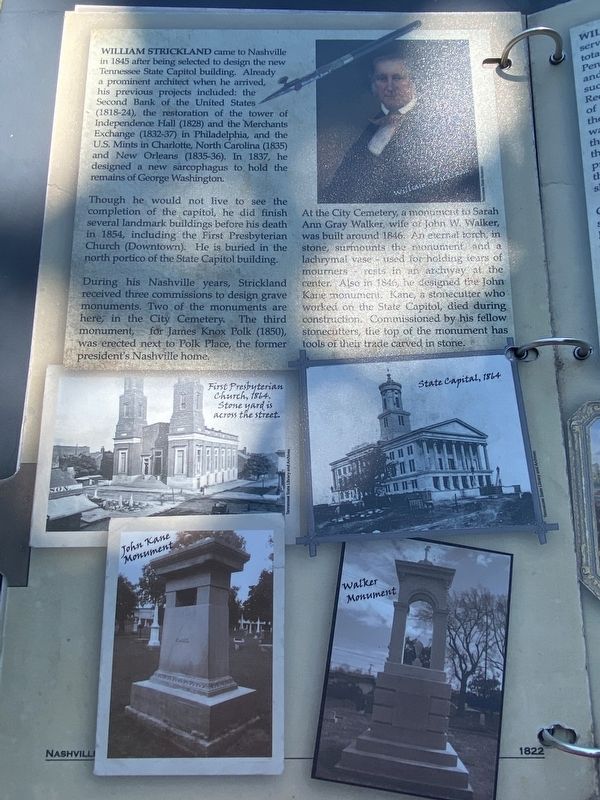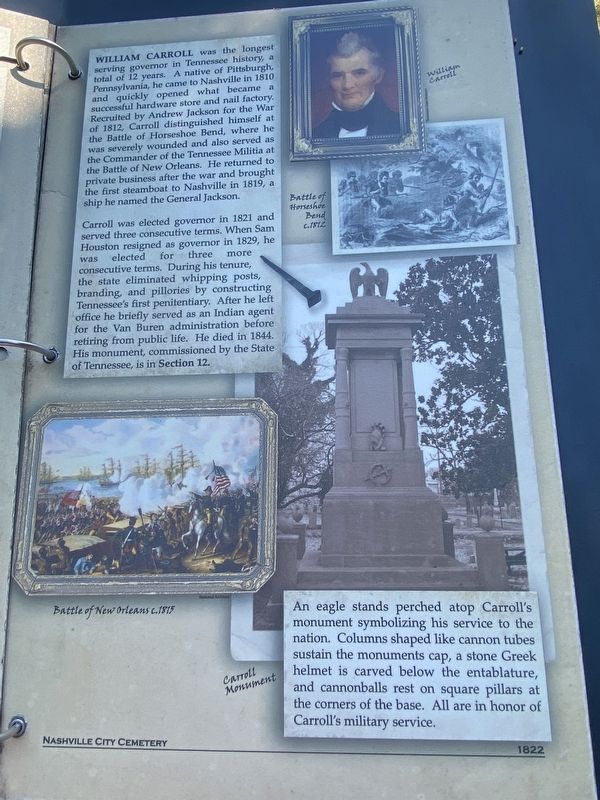South Nashville in Davidson County, Tennessee — The American South (East South Central)
Cemetery Monument and Architecture
Flat headstones and footstones date back hundreds of years. They are also some of the earliest used in the City Cemetery.
Box Tombs or False Crypts are distinguished by their sarcophagus appearance. These vaults are only symbolic in appearance. The real coffin is buried below the crypt.
Table Stones were stone tablets inscribed with the departed's name and typically supported by six legs.
Cenotaphs are monuments erected in memory of an individual who is buried in another location. One cenotaph honors John Sevier, Tennessee's first governor, who was buried in Knoxville.
Obelisks were common cemetery features in the 1840s and 50s when Egyptian Revival architecture became popular in the United States. They were seen as patriotic.
Vaults, both underground and above-ground, also known as mausoleums, are traditionally used for family remains.
Some grave markers did not follow conventional architectural designs, for instance, William Driver's monument is a broken tree with an anchor resting at the base (Section 20); Ann Rawlings Sanders' grave is marked by a large natural limestone rock topped with an iron lantern (Section 18); and Alex C. Brown, a nineteen-year- old fireman who died in 1839 in the line of duty, is commemorated with a replica of a fire hydrant made of stone. He is buried in Section 28.2.
Prominent Nashville architects contributed their skill and expertise to monuments and structures built in the City Cemetery. Two of the best known architects from the 19th century were Adolphus Heiman and William Strickland.
Adolphus Heiman (1809-1862) was born in Prussia and trained as a stonecutter in the Prussian Royal Service before immigrating to the U. S. in 1834. In 1837, Heiman arrived in Nashville and within a few years he owned an engineering company that designed bridges, public. buildings, private homes, and cemetery monuments. His career took a brief respite. in 1848 when he served in the Mexican War, surviving the bloody Battle of Monterey, before returning to Nashville to resume his architectural and engineering practice.
Between 1849 and 1861 he designed and built several Nashville landmarks, including: Belmont Mansion (1859), the State Hospital for the Insane (1849), the Literary Building at the University of Nashville (1854), the Adelphi Theater (1850), and St. Mary's Catholic Church (1847). In 1861 he joined the 10th Tennessee Infantry (CSA). Heiman, a colonel, was captured at Ft. Donelson in February 1862, was later released, and died in Jackson, Mississippi, in 1863. He was removed to Mt. Olivet in 1870.
At the City Cemetery Heiman is credited with designing and fabricating the headstone of Benjamin Sharpe (1848) and monument of Nancy Maynor (c. 1838, Section 19). Though Maynor died in 1837 before Heiman arrived, the monument was added at a later date.
William Strickland came to Nashville in 1845 after being selected to design the new Tennessee State Capitol building. Already a prominent architect when he arrived, his previous projects included: the Second Bank of the United States (1818-24), the restoration of the tower of Independence Hall (1828) and the Merchants Exchange (1832-37) in Philadelphia, and the U.S. Mints in Charlotte, North Carolina (1835) and New Orleans (1835-36). In 1837, he designed a new sarcophagus to hold the remains of George Washington.
Though he would not live to see the completion of the capitol, he did finish several landmark buildings before his death in 1854, including the Firs Presbyterian Church (Downtown). He is buried in the north portico of the State Capitol building. During his Nashville years, Strickland received three commissions to design grave monuments. Two of the monuments are here, in the City Cemetery. The third monument, for James Knox Polk (1850), was erected next to Polk Place, the former president's Nashville home. At the City Cemetery, a monument to Sarah Ann Gray Walker, wife of John W. Walker, was built around 1846. An eternal torch, in stone, surmounts the monument and a lachrymal vase - used for holding tears of mourners - rests in an archway at the center. Also in 1846, he designed the John Kane monument. Kane, a stonecutter who worked on the State Capitol, died during construction. Commissioned by his fellow stonecutters, the top of the monument has tools of their trade carved in stone.
William Carroll was the longest serving governor in Tennessee history, a total of 12 years. A native of Pittsburgh, Pennsylvania, he came to Nashville in 1810 and quickly opened what became a successful hardware store and nail factory. Recruited by Andrew Jackson for the War of 1812, Carroll distinguished himself at the Battle of Horseshoe Bend, where he was severely wounded and also served as the Commander of the Tennessee Militia at the Battle of New Orleans. he returned to private business after the war and brought the first steamboat to Nashville in 1819, a ship he named the general Jackson.
Carroll was elected governor in 1821 and served three consecutive terms. When Sam Houston resigned as governor in 1829, he was elected for three more consecutive terms. During his tenure, the state eliminated whipping posts, branding, and pillories by constructing Tennessee's first penitentiary. After he left office he briefly served as an Indian agent for the Van Buren administration before retiring from public life. he died in 1844. His monument, commissioned by the State of Tennessee, in in Section 12.
An eagle stands perched atop Carroll's monument symbolizing his service to the nation. Columns shaped like cannon tubes sustain the monuments cap, a stone Greek helmet is carved below the entablature, and cannonballs rest on square pillars at the corners of the base. All are in honor of Carroll's military service.
Topics. This historical marker is listed in this topic list: Cemeteries & Burial Sites.
Location. 36° 8.896′ N, 86° 46.163′ W. Marker is in Nashville, Tennessee, in Davidson County. It is in South Nashville. Marker can be reached from 4th Avenue South (Tennessee Route 11). Located within Nashville City Cemetery. Touch for map. Marker is at or near this postal address: 1012 TN-11, Nashville TN 37210, United States of America. Touch for directions.
Other nearby markers. At least 8 other markers are within walking distance of this marker. In Memory of Charles Maddis (within shouting distance of this marker); Andrew Ewing (within shouting distance of this marker); William Carroll (within shouting distance of this marker); City Cemetery (within shouting distance of this marker); Erected November 21, 1909 (within shouting distance of this marker); In Memory of the Confederate Soldiers Who Were Buried in the City Cemetery (within shouting distance of this marker); A Community of Citizens and Soldiers (about 300 feet away, measured in a direct line); From Frontier to Civilization (about 300 feet away). Touch for a list and map of all markers in Nashville.
Credits. This page was last revised on February 7, 2023. It was originally submitted on August 24, 2022, by Darren Jefferson Clay of Duluth, Georgia. This page has been viewed 131 times since then and 16 times this year. Photos: 1, 2, 3, 4. submitted on August 24, 2022, by Darren Jefferson Clay of Duluth, Georgia. • Mark Hilton was the editor who published this page.
Editor’s want-list for this marker. A wide shot of the marker and its surroundings. • Can you help?



